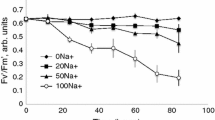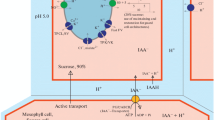Abstract
The concentration of potassium chloride required in the incubation medium to open stomata in isolated epidermal tissues of Commelina communis L. and Vicia faba L. could be lowered from 100 mM to 10 mM if the proton concentration of the ambient solution was increased from pH 5.6 to pH 3.5. This acidification effect was formerly attributed to the destruction of epidermal and subsidiary cells resulting in a relief of back pressure upon guard cells. While guard cells remain viable at pH 3.5, as demonstrated by their susceptibility to inhibition by uptake of glucose or to uncoupling by DNP, incipient destruction of the cells surrounding them could first be observed 30 min after the onset of the incubation experiment. By this time, however, the stomata had already opened; the time course of stomatal opening at pH 3.5 did not show any lag phase corresponding to the time required for damaging epidermal cells and showed no difference to that at pH 5.6 Thus, the acid-stimulated opening of stomata appears to be a biphasic phenomenon consisting of a physiologic effect onto which the physical effect of the relief of back pressure is superimposed over longer periods of incubation. To interpret the physiologic role of an increased proton concentration in the ambient solution of isolated epidermal strips, it is suggested that guard cells take up protons and chloride ions in an electroneutral symport. While protons are extruded again to generate the negative membrane potential required for potassium influx, chloride ions are retained to maintain electroneutrality.
Similar content being viewed by others
References
Dittrich, P., Mayer, M.: Inhibition of stomatal opening during uptake of carbohydrates by guard cells in isolated epidermal tissues. Planta 139, 167–170 (1978)
Marrè, E.: Effects of fusicoccin and hormones on plant cell membrane activities: observation and hypotheses. In: Regulation of cell membrane activities in plants, pp. 185–202, Marrè, E., Ciferri, O., eds. Amsterdam: Elsevier 1977
Moody, W., Zeiger, E.: Electrophysiological properties of onion guard cells. Planta 139, 159–165 (1978)
Pallaghy, C.K.: Electrophysiological studies in guard cells of tobacco. Planta 80, 147–153 (1968)
Raschke, K.: Stomatal action. Ann. Rev. Plant. Physiol. 26, 309–340 (1975)
Raschke, K., Dittrich, P.: 14C-Carbon-dioxide fixation by isolated leaf epidermes with stomata closed or open. Planta 134, 69–75 (1977)
Raschke, K., Schnabl, H.: Availability of chloride effects the balance between potassium, chloride, and malate in guard cells of Vicia faba L. Plant. Physiol. 62, (1978), in press
Raven, J.A., Smith, F.A.: Characteristics, function and regulation of active proton extrusion. In: Regulation of cell membrane activities in plants, pp. 25–40, Marrè, E., Ciferri, O., eds. Amsterdam: Elsevier 1977
Robertson, R.N.: The separation of protons and electrons as a fundamental biological process. Endeavour 26, 134–139 (1967)
Schnabl, H.: The effect of Cl- upon the sensitivity of starchcontaining and starch-deficient Stomata and guard cell protoplasts towards potassium ions, fusicoccin and abscisic acid. Planta 144, 95–100 (1978)
Schnabl, H., Raschke, K.: The role of chloride as counter ion of potassium during stomatal movement in Allium cepa L., a species devoid of starch in guard cells. Plant Physiol. 62, (1978), in press
Spear, D.G., Barr, J.K., Barr, C.E.: Localization of hydrogen ion and chloride ion fluxes in Nitella. J. Gen. Physiol. 54, 397–413 (1969)
Squire, G.R., Mansfield, T.A.: A simple method of isolating stomata on detached epidermis by low pH treatment: observations of the importance of the subsidiary cells. New Phytol. 71, 1033–1043 (1972)
Squire, G.R., Mansfield, T.A.: The action of fusicoccin on stomatal guard cells and subsidiary cells. New Phytol. 73, 432–440 (1974)
Travis, A.J., Mansfield, T.A.: Studies of malate formation in isolated guard cells. New Phytol. 78, 541–546 (1977)
Willmer, C.M., Pallas, Jr., J.E.: A survey of stomatal movements and associated potassium fluxes in the plant kingdom. Can. J. Bot. 51, 37–42 (1973)
Author information
Authors and Affiliations
Rights and permissions
About this article
Cite this article
Dittrich, P., Mayer, M. & Meusel, M. Proton-stimulated opening of stomata in relation to chloride uptake by guard cells. Planta 144, 305–309 (1979). https://doi.org/10.1007/BF00391572
Received:
Accepted:
Issue Date:
DOI: https://doi.org/10.1007/BF00391572




